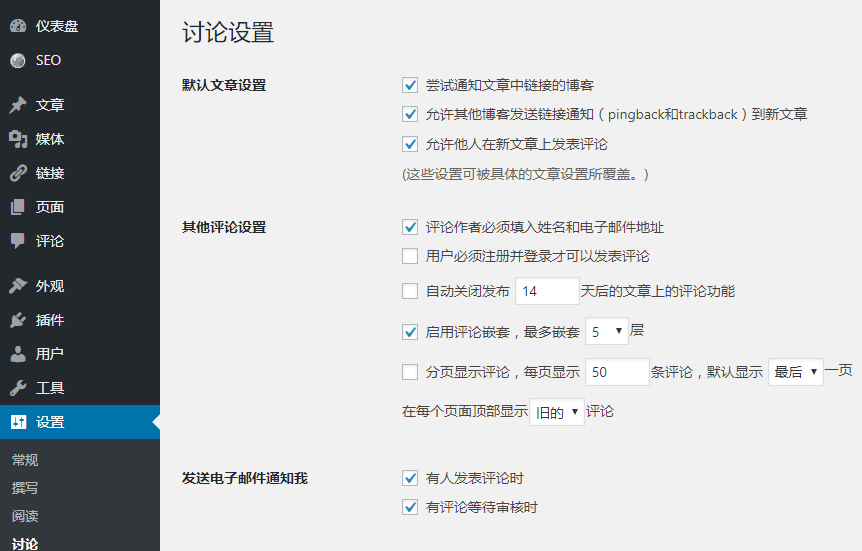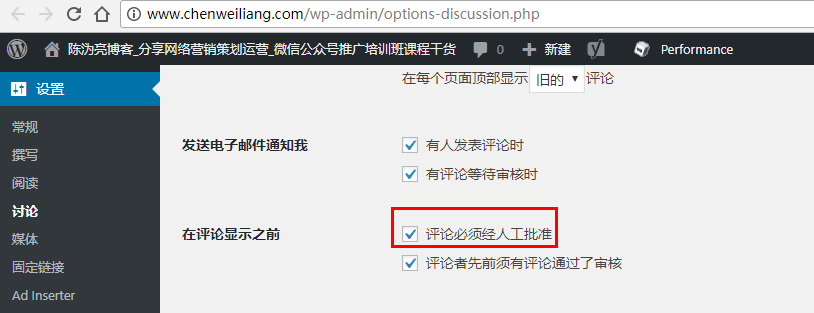Article directory
WordPressWhat are the functions of Ping, Trackback and Pingback in ?
new mediapeople atWordPress backendWhen writing an article, click "Display Options" in the upper right corner, there will be the following options to check (depending on the installation andWordPress pluginand WordPress themes, the options shown here, will also be slightly different).
What exactly is "Send Trackback" as shown in the figure below?

When it comes to Trackback of Wordpress, it is necessary to explain what the functions of Ping, Trackback and Pingback are?
The functions of Ping, Trackback, and Pingback are as follows:
- Ping:update notification
- Pingback:Citation Notice
- Trackback:Automatic Citation Notification
What does Ping mean?
When it comes to Ping, what everyone is most familiar with is the action of pinging a site.
In the blog system, Ping is an update notification service based on the XML-RPC standard protocol. It is a way for blogs to notify Ping servers such as search engines for timely crawling and indexing when content is updated.
This is an efficient solution compared to passively waiting for search engines to crawl.At the same time, the notification services of Trackback and Pingback mentioned below are implemented with the help of the "Ping" function.
You can use the ping service in two ways: manual notification and automatic notification:
Manual ping:Visit the Submit Blog page of the blog search engine and submit the blog address.For example, in Baidu blog search, visit http://ping.baidu.com/ping.html page, enter the blog address or feed address in the input box, and click the "Submit Blog" button.
Automatic ping:If the blog program supports the automatic ping function, you only need to configure the Ping service address to your blog publishing background or client program, and the automatic notification function can be realized.
In WordPress, the automatic ping function is displayed in the "Update Service" in "Background" → "Settings" → "Write". In this section, you can set up to notify these servers that your blog has published new articles when the article is published. The crawlers of search engines come to crawl and index your new articles.

The following isChen WeiliangPartial list of "automatic ping services" used by the blog's server:
http://rpc.pingomatic.com http://rpc.twingly.com http://www.blogdigger.com/RPC2 http://www.blogshares.com/rpc.php http://www.blogsnow.com/ping http://bulkfeeds.net/rpc http://ping.blo.gs/ http://ping.feedburner.com http://ping.weblogalot.com/rpc.php http://www.feedsubmitter.com http://blo.gs/ping.php http://www.pingmyblog.com http://ipings.com http://www.weblogalot.com/ping
What does Trackback mean?
TrackBack lets bloggers know who has seen their articles and wrote short articles about them.In Movable Type and WordPresssoftware, including this function.This function realizes mutual announcement between websites by displaying the article link and comment content of the referrer in the comments; realizes the communication and interaction between blogs, and enables more people to join the discussion on a topic.
The TrackBack function generally appears in the comments below a blog post, and also displays the summary information, URL and title of the other party's blog post.
The TrackBack specification was developed by Six Apart in 2000 and implemented in Movable Type 2.2.In the earlier version of the Trackback specification, Ping was an HTTP request in the GET method. Now the GET method is no longer supported, and only the POST method can be used.
The use of Trackback is completely manual, and data transfer is done via the HTTP POST protocol.Since Trackback currently exists only for compatibility with the old blog system, only a small tool for sending Trackback is reserved in the article editing page in WordPress.
In this column, you can fill in the referenced web pages, the URL of the article, etc. when writing this article, and separate each URL with a space. When the article is sent, it will automatically send a Trackback to the website you specify, and Presented in the form of comments.
On the page of writing articles in WordPress, after checking "Send Trackback", the following "Send Trackback to" module will appear:

What does Pingback mean?
The emergence of Pingback is entirely to solve the many problems of Trackback.
But for users, the biggest advantage is that the use of Pingback is completely automatic, which is why I translate Pingback as "automatic reference notification".
When you add a series of links to articles based on the WordPress system in an article and publish the article, your WordPress system will automatically pick out the links from the article and try to send a pingback to these systems.The WordPress site where these links are located will display the pingback information in the comments after receiving the pingback.
The Chinese explanation of Pingback function is "quote". When your article refers to other people's content (usually there is a hyperlink of the other party in the content), once the article is published, the Pingback function will be automatically activated, which will send a Ping to the other party, it will be presented in the form of comments (it is estimated that many bloggers sometimes see a comment with the same content as the content of their new article when they publish an article. This is the "side effect" of the Pingback function, which will be explained in detail below. ).
The object of sending Ping depends on all the URLs (hyperlinks) in the article.In other words, if the article mentions too many URLs, it may overload your server.As a reminder, if you spam such a pingback, it will cause it to be marked as spam.
In WordPress, this Pingback function exists in "Background" → "Settings" → "Discussion", find the "Default Article Settings", the setting here is to enable your article to enable the Pingback function and whether Accept pingbacks and trackbacks from other bloggers.
As shown in the figure below, you can enable Pingback and Trackback functions in discussions in WordPress:

In WordPress, it is also possible to set whether to receive Pingback and Trackback notifications on a per-post basis.This can be seen in the Trackback section of the article editing page.
The difference between Pingback and Trackback
- Pingback uses XML-RPC protocol, while trackback uses HTTP POST protocol;
- Pingback supports automatic detection, the blog system automatically discovers the links in the article, and tries to use the Pingback method to notify these links, while Trackback must manually enter all links;
- Article summary sent by Pingback, is near the linkCopywritingcontent, while Trackback completely requires manual entry of summaries.
Pingback and Trackback presentation
So what happens when Pingback and Trackback are sent to other people's website notifications?Generally speaking, the content sent in the past will be presented in the form of "comments".
In terms of "Pingback", it will grab some text near the mentioned hyperlink as the message content. The name and URL of the commenter are the article name and URL of your article, and the message IP is your server. IP.If you view it in the backend of WordPress, it will be presented in the following way. Of course, the frontend depends on the comment style set by the blogger.
If it is "Trackback", it will grab some of the text in the first paragraph of the article as the message content. The name and URL of the commenter will be your article, and the message IP will be the IP of your website.
Exposure and Spam
I believe everyone will be concerned about the "exposure rate" brought by this Pingback and Trackback?
Because both Pingback and Trackback are presented as comments, in other words, if they are included in the comment area, people will see your citation information. If others are interested in your title, they will click in to see it. It can increase the visit rate and free exposure at the same time.
However, in terms of WordPress, some themes will mix messages, Pingback, and Trackback, while others will have independent messages, Pingback and Track areas, and even some websites only display messages, so the effect of exposing this part is actually limited. Many foreign spam websites like to use Pingback and Tarckback to blow up your messages.
Since neither Trackback nor its successor, Pingback, has solved a problem, which is the authenticity of notification information, there is a real problem of using software to spam Trackback or Pingback.Since both Trackback and Pingback will show up in the comments and contain manyE-commerceWebsite doWeb Promotion, so it becomes some websites through spamming external linksSEOs method.
To solve this problem, check the "Comments must be manually approved" option in WordPress "Admin" → "Settings" → "Discussion" → "Before Comments Display".

This way, you have the opportunity to sift through the comments before any spam shows up in your WordPress comments.In addition, the built-in Akismet comment filter plugin in WordPress can help you filter almost all spam comments.
Attention points
Finally, a reminder, when WP blog has enabled Pingback, don’t let your Trackback also send out the same article to the same website, causing the same article to have two links, Pingback and Trackback, because it is very likely that the other party’s defense The spam message message mechanism will misjudge you as spam, so the gains outweigh the losses!
Hope Chen Weiliang Blog ( https://www.chenweiliang.com/ ) shared "What are the functions of Ping, Trackback and Pingback in WordPress? , to help you.
Welcome to share the link of this article:https://www.chenweiliang.com/cwl-530.html
Unlock AI assistance and say goodbye to inefficient work! 🔓💼
🔔 Get the "DeepSeek Prompt Word Tool" immediately in the channel pinned directory! 🎯
📚 Miss out = Fall behind forever! Act now! ⏳💨
If you like it, please share and like it! Your sharing and likes are our continuous motivation!
